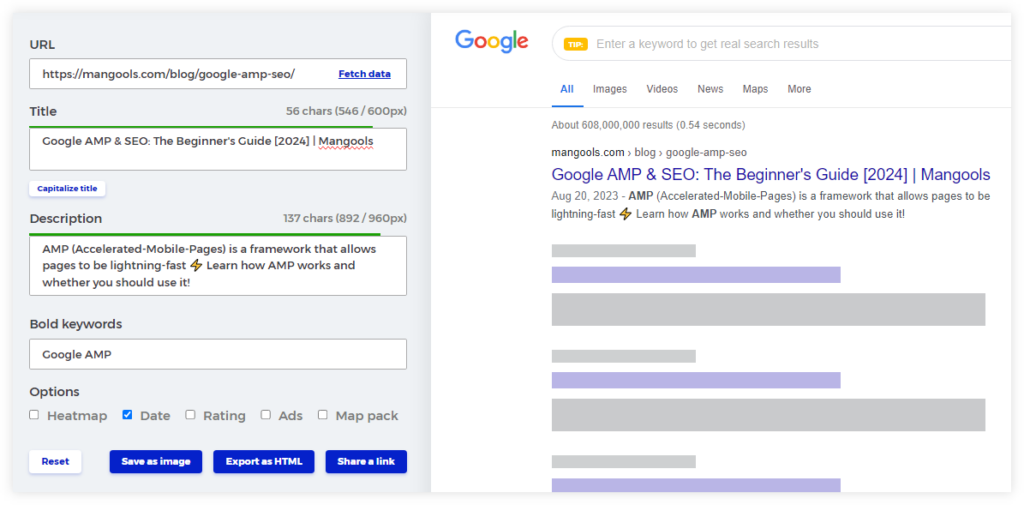URL slugs: such small, insignificant things, and yet such an important aspect of the SEO world.
Every website has them, but not every site optimizes them.
And no, we are not talking about those weird, slow creatures in your garden 🙂 In this article, we will explore:
- What URL slugs exactly are
- How slugs can affect your SEO efforts
- How to optimize URL slugs for SEO
- How to create slugs in WordPress
Let’s get into it.
What is a URL slug?
URL slug is the end part of the full URL address after the slash (“/”) sign that serves as a specific identifier of the web page.
The purpose of the URL slug is to help users and search engines better navigate within the website’s content and quickly understand what it is about.
Here’s an example of the full URL address:
https://mangools.com/blog/google-amp-seo/
In this case, we can divide the given URL address into:
https://– a protocolmangools.com– a domain/blog/google-amp-seo/– a pathgoogle-amp-seo– a URL slug
Slugs can be located either right after the domain name or at the end of the URL path and play an important role in the overall URL structure of the website.
Why is a URL slug important in SEO?
URL slugs are integral to SEO because they directly influence how search engines index and understand your content.
When it comes to the practical benefits of URL slugs from an SEO perspective, it all boils down to:
Let’s take a look at both aspects a little bit more.
a) Improved SEO relevancy
URL slugs help search engines better understand the topic of the web page and therefore enhance a page’s visibility in SERPs.
By having a focus keyword in the URL address, Google can categorize and rank your content more accurately for the queries that are relevant to the page’s content:
“We use the words in a URL as a very very lightweight factor. And from what I recall, this is primarily something that we would take into account when we haven’t had access to the content yet.” (John Mueller, Google Search Advocate)
So, for example, using a slug like “healthy-vegetarian-recipes” for a page about vegetarian cooking tips directly matches common search queries, improving the page’s relevance and rankings in search results.
b) Better user experience
A well-crafted slug is crucial for SEO as it makes your URL more understandable to both users and search engines.
It also makes it easier to remember — and after all, you do want readers to be able to find you easily, right?
Think of a URL slug as the unsung hero of your website’s SEO journey, much like a garden slug quietly shaping the landscape.
Just as a slug leaves a trail, a URL slug is the trailblazing part of your website’s address that guides both users and search engines to your content.
For example, instead of using random or generated slugs like:
https://example.com/95463-page/
… you should always try to write clear, concise slugs that inform users about the content, encouraging clicks from interested parties. Such as:
https://example.com/beginners-guide-to-yoga/
This clarity boosts user trust and satisfaction, as visitors are more likely to stay on a page that matches their search intent.
How to optimize URL slugs for SEO?
Optimizing URL slugs is a key step in SEO strategy, as it helps enhance both search engine rankings and user experience.
The best slugs are short, descriptive, and contain keywords relevant to the page content, improving the website’s search engine optimization and UX.
Here are eight essential steps to make the most of your URL slug:
1. Add your focus keyword
Incorporating a focus keyword in your slug boosts SEO by aligning with what users are searching for.
For example, if you checked keywords in our KWFinder tool and decided to rank for a query like “organic gardening tips“, it is natural to include the given focus keyword into the slug of your web page.
On-page optimizations like these help search engines better understand what your content is all about and how to rank it in the Search.
2. Keep it short
A concise slug is more effective and user-friendly.
Always aim for brevity while maintaining descriptiveness.
For example, it’s better to use “easy-pancake-recipe” rather than “find-the-best-easy-pancake-recipe-here“.
The shorter version is straightforward and easier to read, making it more appealing to both users and search engines.
3. Be descriptive
Your slug should act as a mini-summary of your page’s content.
For example, a blog post about budget travel in Europe would benefit from a slug like “budget-travel-europe-tips” rather than “travel-tips“.
This informs not only users about the specific content of the page but also helps search engines match the page to relevant queries.
In addition to that, you should always make sure to avoid slugs that don’t mean anything. For example:
- Good URL slug:
homemade-chocolate-chip-cookies– you know right away what the page offers. - Bad URL slug:
article12345– random, general, and hard to remember.
4. Avoid special characters
Special characters can be problematic for both readability and search engines.
For a page on children’s toy reviews, the “best-childrens-toys” slug is more preferable as opposed to a confusing “best-children’s-toys@2023” slug.
Stick to simple, clean text that can be easily read and processed.
Emojis in URLs can also create confusion and compatibility issues.
Many browsers and search engines struggle to process emojis correctly, leading to broken or unfindable links.
Although they are certainly visually appealing, emojis can negatively affect a URL’s functionality and accessibility, making them unsuitable for professional website slugs.
5. Separate words in the slug
A bunch of words typed in a row are simply too hard to read.
For example, a slug like “besttourssouthamerica” probably took you a few seconds to check, but the “best-tours-south-america” slug definitely needed just a quick glance to understand.
That’s because spaces in between words simply improved readability.
Therefore, always use hyphens (and avoid underscores if possible) to separate words and make your URL easier to read and more SEO-friendly.
Why?
Because hyphens are recognized as spaces in the eyes of Google which enhances the URL’s readability and SEO effectiveness.
Hyphens also just look better: “summer-fashion-trends” is more readable and better for search engines than “summerfashiontrends” or “summer_fashion_trends“.
6. Try to avoid stop-words
While stop words like “and,” “or,” “but,” and “the” are natural in language, they often aren’t necessary in URLs and can make slugs longer and less straightforward.
For example, “tips-for-effective-studying” is more efficient than “the-tips-and-tricks-for-effective-studying“.
By omitting these stop words, your URL remains focused on the essential keywords, enhancing clarity and SEO impact.
Other common stop words that should be omitted in URL slugs for better SEO are:
- “
a“ - “
an“ - “
in“ - “
on“ - “
for“ - “
with“
7. Use lowercase letters only
URLs should be easy to type and remember.
Using lowercase letters uniformly prevents errors and confusion, as users might not remember the correct case.
For instance, “vintage-car-collection” is more user-friendly and less prone to mistakes than “Vintage-Car-Collection“.
Consistent lowercase usage in URLs ensures accessibility and avoids issues caused by case sensitivity in some servers.
Additionally, utilizing lowercase in URLs promotes a uniform, professional appearance for your website.
It aligns with the general internet convention for URLs, making your links more standardized and easily recognizable.
8. Avoid years or dates (if possible)
Dates can quickly make the content seem outdated.
Instead, opt for timeless slugs that remain relevant whenever possible.
For example, rather than “marketing-trends-2024“, which will feel outdated next year, “evergreen-marketing-trends” retains its relevance.
This approach ensures your content remains attractive over time, maximizing its long-term SEO value and user appeal.
When considering the use of dates in your slug, it might be tempting to think it’s okay to include the current year (like 2024) and then update it later.
However, it’s best to resist this urge.
Constantly changing URLs can negatively affect SEO and disrupt user experience, even with the use of redirects.
When crafting your slug, it’s important to choose one that will remain relevant and accurate for the long term.
How to add and edit URL slugs in WordPress
Customizing URL slugs in WordPress is a simple and straightforward process that can significantly enhance your site’s SEO and user experience.
Whether you’re publishing a new post or updating an existing one, adjusting the slug allows you to ensure that your URLs are not only search engine friendly but also clear and descriptive for your readers.
This customization plays a vital role in how your content is presented and discovered online.
In WordPress, the process of adding or editing slugs is integrated seamlessly into the content creation workflow, making it accessible even for those who are not technically inclined:
- Log in to your WordPress dashboard
- Navigate to Posts or Pages – once logged in, find ‘Posts’ or ‘Pages’ on the left-hand sidebar. Here, you can either select an existing post/page to edit or create a new one, depending on your need.
- Locate the permalink – in the editing screen, on the right side of the editor, there’s the “Post”/”Block” section. This shows the URL of your post/page and includes the slug at the end.
- Click on the “URL” part in the “Post” section and edit the URL slug according to your needs.
- Make sure the slug is concise, includes your focus keyword, and uses hyphens to separate words for better readability and SEO.
- Don’t forget to hit ‘Update‘ or ‘Publish‘ to apply these changes to your post or page.

Tip: You can use our free SERP Simulator tool to quickly check how your URL slug would actually look like in Google Search.
In addition to that, the SERP simulator can help you to visually check other aspects of the organic snippet, such as:
- Title tags
- Meta descriptions
- Structured data markups (e.g. ratings, dates, etc.)







